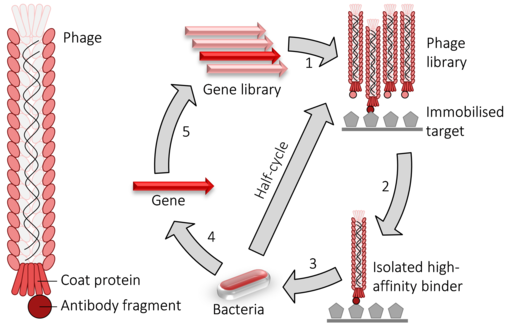Phage display, first developed in 1985 by George P. Smith, is a powerful technique that allows the presentation of peptides or proteins on the surface of bacteriophages, enabling the high-throughput screening and selection of molecules with desired binding properties. Over the years, phage display has become an invaluable tool for the discovery of novel therapeutic agents, including nanobodies. This article will describe how phage display libraries can be prepared to facilitate the discovery of therapeutic nanobodies.

Thomas Shafee, CC BY 4.0, via Wikimedia Commons
Immunization and RNA Extraction
The first step in preparing a phage display library for nanobody discovery involves immunizing a camelid, such as a llama or alpaca, with the target antigen of interest. The animal's immune system responds by producing heavy-chain-only antibodies (HCAbs) specific to the target antigen. After a few weeks, peripheral blood lymphocytes (PBLs) are collected from the immunized animal, and the total RNA is extracted from these cells.
cDNA Synthesis and Amplification of VHH Domains
Next, reverse transcription is performed to convert the isolated RNA into complementary DNA (cDNA). Polymerase chain reaction (PCR) is then used to amplify the variable domain (VHH) encoding sequences from the cDNA, using specifically designed primers that recognize conserved regions within the heavy-chain-only antibody genes.
Cloning VHH Fragments into Phage Display Vectors
The amplified VHH fragments are cloned into a suitable phage display vector, typically a modified filamentous bacteriophage like M13 or fUSE5. These vectors contain a phage coat protein gene fused to a multiple cloning site, allowing the VHH fragments to be displayed on the surface of the phage particles. Upon successful ligation of the VHH fragments into the phage display vector, the resulting recombinant plasmids are transformed into competent Escherichia coli (E. coli) cells.
Production of the Phage Display Library
The transformed E. coli cells are infected with helper phages, which provide the necessary components for the assembly and secretion of functional phage particles displaying the VHH fragments on their surface. The resulting phage particles are then purified from the bacterial culture supernatant, creating a diverse phage display library representing a wide range of nanobodies specific to the target antigen.
Selection of Target-specific Nanobodies
The prepared phage display library is subjected to a process called "biopanning" to select nanobodies with high affinity and specificity for the target antigen. This involves incubating the phage library with immobilized target antigen, followed by several rounds of washing to remove non-binding phages. The bound phages, which display target-specific nanobodies, are then eluted, amplified in E. coli, and subjected to additional rounds of biopanning to enrich the selection of high-affinity binders.
Characterization and Further Development
After several rounds of biopanning, individual phage clones displaying target-specific nanobodies are isolated, sequenced, and further characterized for their binding properties and functional activities. The selected nanobodies can then be produced in large quantities using bacterial or yeast expression systems and optimized for therapeutic applications through protein engineering techniques.
Phage display libraries play a crucial role in the discovery and development of therapeutic nanobodies. By providing a high-throughput platform for the selection and characterization of target-specific binders, phage display has accelerated the progress of nanobody research and opened avenues for novel therapeutic strategies across various diseases. As the field continues to evolve, phage display technology will undoubtedly remain at the forefront of nanobody discovery and development.